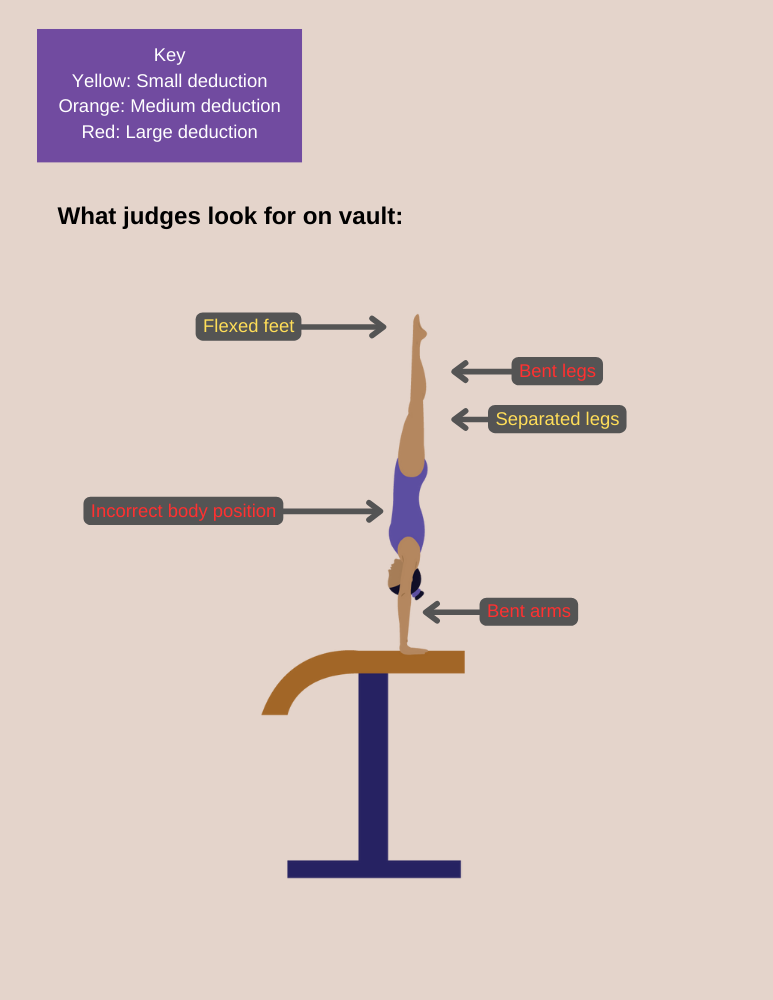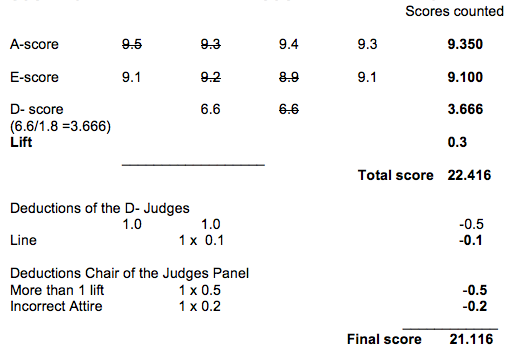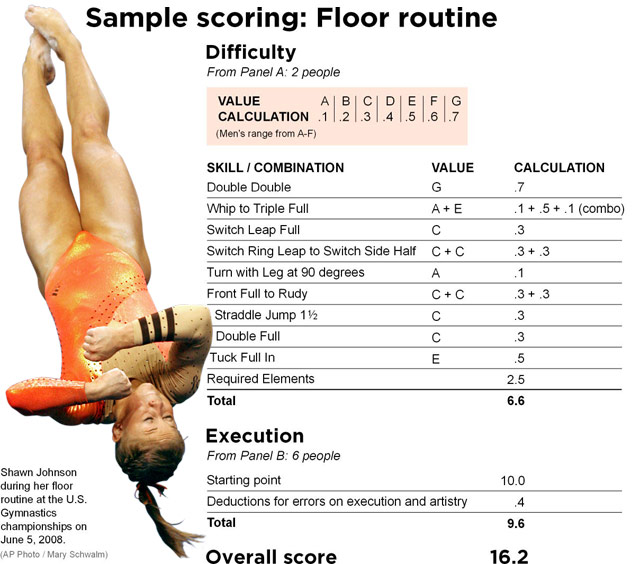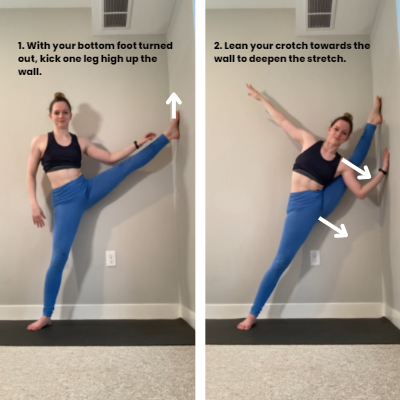Scoring gymnastics can be complex but understanding it is crucial. Judges consider many factors to determine scores.
Gymnastics is a sport that combines strength, grace, and precision. For both athletes and fans, knowing how judges score routines enhances appreciation of the sport. Judges evaluate routines based on difficulty, execution, and artistry. Each element must be performed with perfection to achieve high marks.
This scoring system ensures fairness and encourages gymnasts to push their limits. Understanding the criteria can also help athletes improve their performances. Whether you are a gymnast, coach, or fan, learning the scoring process adds depth to your experience. This guide will break down the essential aspects of scoring gymnastics, making it easier to follow and appreciate.
Introduction To Gymnastics Scoring
Gymnastics is a sport that combines strength, flexibility, and artistry. Scoring in gymnastics can seem complex. Judges evaluate routines based on specific criteria. Each performance gets a score that reflects the gymnast’s skill and execution.
Importance Of Scoring
Scoring in gymnastics determines the winner of a competition. It also helps gymnasts understand their strengths and areas for improvement. Accurate scoring ensures fair competition and motivates athletes to strive for excellence.
Basic Scoring Principles
Gymnastics scoring includes two main components: the difficulty score and the execution score. The difficulty score measures the complexity of the routine. The execution score assesses how well the gymnast performs the routine.
Judges deduct points for mistakes. These can be falls, steps, or poor form. Each mistake has a specific deduction value. The final score is the sum of the difficulty and execution scores, minus any deductions.

Credit: gymnasticshq.com
Judging Panels And Roles
Gymnastics scoring is a complex system. It involves a team of judges who evaluate each performance. The judging panel plays a crucial role in ensuring fair and accurate scores. Here, we will discuss the different types of judges and their responsibilities.
Types Of Judges
There are various types of judges in gymnastics. Each has a unique role:
- Difficulty Judges (D-Judges): They evaluate the difficulty of the routines.
- Execution Judges (E-Judges): They focus on the execution, artistry, and technique.
- Reference Judges: They help resolve discrepancies in scores.
- Superior Jury: They oversee the entire judging process.
Responsibilities Of Judges
Each judge has specific responsibilities to ensure the scoring is fair:
- Difficulty Judges (D-Judges):
- Assess the difficulty level of the gymnast’s routine.
- Assign difficulty scores based on the elements performed.
- Execution Judges (E-Judges):
- Evaluate the execution of movements.
- Deduct points for errors and form breaks.
- Reference Judges:
- Compare scores from D and E judges.
- Resolve any significant score differences.
- Superior Jury:
- Monitor the overall judging process.
- Ensure rules and standards are applied consistently.
Understanding the roles and responsibilities of each judge is key. It ensures transparency and accuracy in gymnastics scoring.
Scoring System Breakdown
Understanding the scoring system in gymnastics can seem complex. This breakdown simplifies the essential components. Judges use two main scores: the Difficulty Score and the Execution Score. Each score plays a crucial role in the overall rating of a gymnast’s performance.
Difficulty Score
The Difficulty Score reflects the complexity of the routine. Judges assess the skills and elements performed. Each element has a specific value. The more challenging the skill, the higher the value. Gymnasts aim to perform high-value elements to boost their Difficulty Score. Combining multiple difficult skills can lead to a higher total. Judges add the values to get the final Difficulty Score.
Execution Score
The Execution Score evaluates how well the routine is performed. Judges look for precision, form, and technique. They start with a perfect score of 10.0. For every mistake, they deduct points. Small errors lead to minor deductions. Major mistakes result in larger deductions. The goal is to have the fewest deductions possible. Clean routines with excellent form receive higher Execution Scores.
Artistry And Presentation
Scoring gymnastics involves more than just physical skills. The artistry and presentation of a gymnast’s routine are crucial. These elements bring the performance to life and captivate the audience. Judges pay close attention to these aspects, which can make or break a routine.
Artistic Impression
The artistic impression of a gymnastics routine is vital. It includes the gymnast’s expression, creativity, and overall performance quality. Judges look for routines that are engaging and original. They also consider the gymnast’s ability to connect with the audience.
There are several key points judges consider:
- Facial expressions and body language
- The flow and continuity of the routine
- The originality of movements
- The emotional impact of the performance
Choreography And Music
Choreography and music selection are essential parts of a gymnastics routine. They set the tone and enhance the performance. Good choreography matches the music and highlights the gymnast’s strengths. It should be well-planned and synchronized with the gymnast’s movements.
When judging choreography and music, the following aspects are important:
| Choreography | Music |
|---|---|
| Originality and creativity | Suitability to the gymnast’s style |
| Use of space and apparatus | Synchronization with movements |
| Consistency and flow | Emotional impact |
In summary, the artistry and presentation of a gymnastics routine are just as important as technical skills. Judges look for routines that are expressive, creative, and well-synchronized with music. By focusing on artistic impression, choreography, and music, gymnasts can enhance their performances and score higher.
Common Deductions
Understanding common deductions in gymnastics is crucial for both athletes and spectators. These deductions can significantly impact a gymnast’s score. They reflect mistakes or imperfections in the performance. Here, we will break down the common deductions into two main categories: Execution Errors and Artistry Deductions.
Execution Errors
Execution errors are specific mistakes in the gymnast’s movements. These errors can range from minor to major. They often include issues like poor form or balance. Below is a table showing common execution errors and their typical deductions:
| Execution Error | Deduction (in points) |
|---|---|
| Flexed or bent arms/legs | 0.1 – 0.3 |
| Steps on landing | 0.1 per step |
| Fall | 0.5 |
| Incomplete twists/turns | 0.1 – 0.3 |
These errors are easy to spot. Judges deduct points based on the severity of the mistake. Flexed or bent arms/legs are common. Steps on landing can add up quickly. A fall is a significant deduction. Incomplete twists/turns show lack of control.
Artistry Deductions
Artistry deductions focus on the performance’s artistic quality. Judges look for grace, rhythm, and expression. Below are common artistry deductions:
- Lack of expression – 0.1 to 0.3 points
- Poor musical interpretation – 0.1 to 0.3 points
- Lack of originality – 0.1 to 0.2 points
- Inconsistent rhythm – 0.1 to 0.2 points
Artistry is subjective but crucial. Lack of expression affects the overall impact. Poor musical interpretation shows in the gymnast’s movements. Lack of originality makes routines less exciting. Inconsistent rhythm disrupts the flow.

Credit: www.fig-aerobic.com
Scoring For Different Apparatus
Gymnastics scoring can seem complex, but understanding how judges score different apparatus helps. Each apparatus has unique criteria and scoring methods. Knowing these can enhance appreciation of the sport.
Vault Scoring
Vault scoring involves evaluating both the vault itself and the execution. Here’s a breakdown:
- Difficulty Score (D-Score): Based on the vault’s difficulty level.
- Execution Score (E-Score): Starts at 10.0 and deductions are made for errors.
Common deductions include:
- Steps on landing
- Form breaks during flight
- Incomplete twists or turns
Judges combine the D-Score and E-Score for the final score. The higher the difficulty and cleaner the execution, the better the score.
Floor Exercise Scoring
The floor exercise scoring considers both the routine’s difficulty and artistry. Here’s what judges look for:
- Difficulty Score (D-Score): Includes the value of skills and connections.
- Execution Score (E-Score): Begins at 10.0, with deductions for mistakes.
- Artistry Score: Evaluates creativity, choreography, and musical interpretation.
Common deductions in floor exercise:
- Stumbles or falls
- Poor form or body alignment
- Missed connections or elements
A high score requires a balanced routine with difficult skills, clean execution, and artistic performance.
Understanding these scoring methods can deepen your appreciation for the sport. It highlights the athletes’ skills and the judges’ precision.
Tips For Beginners
Gymnastics scoring can seem complex for beginners. With the right tips, you can understand it better. Watching and learning from experienced judges helps. Practicing judging on your own also improves your skills. These tips will ease your journey into gymnastics scoring.
Watching And Learning
Start by watching gymnastics competitions. Focus on how judges score routines. Pay attention to their reactions and notes. Learn the rules and guidelines they follow. Observe the scoring patterns. This helps you understand what judges look for in performances.
Practicing Judging
Practice judging routines yourself. Use videos of past competitions. Score the routines based on what you have learned. Compare your scores with the actual scores. Note the differences and understand why they exist. This practice sharpens your judging skills.
Join online forums or groups for gymnastics enthusiasts. Share your scores and get feedback. This community support helps you improve. Practicing regularly builds your confidence in scoring gymnastics.
Resources For Further Learning
Learning to score gymnastics can seem complex. But, with the right resources, anyone can understand the basics. This section will guide you to valuable books, online courses, and videos. These resources will help you become proficient in gymnastics scoring.
Books And Guides
Books are a great starting point. They offer detailed explanations and examples. “Gymnastics Scoring for Beginners” is a helpful book. It covers all the essential rules and guidelines. Another recommended guide is “The Complete Guide to Gymnastics Judging.” This book breaks down scoring criteria in simple terms. Both books are available at major bookstores and online.
Online Courses And Videos
Online courses provide interactive learning. Websites like Udemy and Coursera offer courses on gymnastics scoring. These courses have video lessons and quizzes. They help reinforce what you’ve learned. YouTube also has many helpful videos. Channels like “Gymnastics HQ” and “Judges Corner” offer free tutorials. These videos are easy to follow and very informative.

Credit: www.nytimes.com
Frequently Asked Questions
What Are The Basics Of Gymnastics Scoring?
Gymnastics scoring is based on difficulty and execution. Judges evaluate routines for technical skill and artistry. Points are deducted for mistakes.
How Do Judges Score Gymnastics Routines?
Judges score routines by evaluating difficulty, execution, and artistry. They deduct points for falls, balance errors, and form breaks.
What Is The Difficulty Score In Gymnastics?
The difficulty score represents the complexity of the routine. It’s calculated based on the skills performed and their combinations.
How Does Execution Affect Gymnastics Scores?
Execution affects scores by assessing the gymnast’s performance quality. Judges look for precision, control, and form, deducting for errors.
Conclusion
Scoring gymnastics may seem complex, but it becomes clearer with practice. Judges look for precision, execution, and artistry. Understanding these key factors helps you appreciate the sport more. Remember, every detail counts in gymnastics scoring. Keep learning and observing to enhance your knowledge.
Supporting your favorite gymnasts becomes even more exciting. So, next time you watch a competition, you’ll know what’s happening. Enjoy the beauty and skill of gymnastics!



